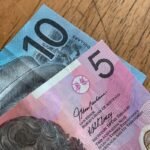- The Pound Sterling falls against the US Dollar as BoE rate-cut bets surge.
- Weak UK Retail Sales lift bets supporting BoE rate cuts in August.
- Investors await the preliminary US/UK S&P Global PMI data for July.
The Pound Sterling (GBP) continues to hold the key support level of 1.2700 against the US Dollar (USD) in Tuesday’s New York session. The GBP/USD pair edges down but remains inside the tight range of 1.2890-1.2940. Meanwhile, the US Dollar (USD) advances due to growing speculation that Donald Trump will win the United States (US) presidential elections in November. The US Dollar Index (DXY), which tracks the Greenback’s value, against six major currencies, jumps to near 104.50.
This week, investors will focus on the US preliminary S&P Global Purchasing Managers Index (PMI) for July, Q2 Gross Domestic Product (GDP), and Durable Goods Orders and Personal Consumption Expenditures Price Index (PCE) data for June. The economic data could provide fresh cues about when the US Federal Reserve (Fed) will start reducing interest rates this year.
Economists expect the Manufacturing PMI, scheduled on Wednesday, to have expanded at a nominal pace to 51.7 from June’s reading of 51.6. The Services PMI, a measure of activities in the service sector, is estimated to have expanded at a slower pace to 54.4 from the prior release of 55.3.
According to the CME FedWatch tool, 30-day Federal Fund futures show the central bank beginning to lower its key borrowing rates from their current levels in the September meeting. The Fed is also expected to cut interest rates again in November or December.
Daily digest market movers: Pound Sterling underperforms its major peers
- The Pound Sterling weakens against its major peers, except the Australian Dollar (AUD) and the New Zealand Dollar (NZD) amid improved speculation that the Bank of England (BoE) will start cutting its key interest rates from the August meeting. Asia-Pacific currencies have been beaten hard due to their strong linkage with China’s economic outlook. Investors have raised concerns over the economic outlook of the world’s second-largest nation due to weaker-than-expected Q2 Gross Domestic Product (GDP) growth.
- The expectations for the BoE to pivot to policy normalization increase as higher interest rates have narrowed pockets of individuals. The recent UK Retail Sales report for June showed that receipts at retail stores unexpectedly contracted by 0.2% year-over-year, which were expected to have grown at a similar pace. Monthly Retail Sales declined at a faster-than-expected pace by 1.2%.
- Meanwhile, expected deceleration in Average Earnings, a key measure of wage growth momentum that prompts inflation in the service sector, has also boosted expectations of BoE rate cuts. Though the wage growth measure has slowed, as expected, in three months ending in May, it is still higher than what needs to be consistent to propel officials’ confidence for rate cuts.
- Going forward, the major trigger for the Pound Sterling will be the UK preliminary S&P Global/CIPS PMI data for July, which will be published on Wednesday. The report is expected to show that the Manufacturing PMI expanded at a faster pace of 51.1 from the former release of 50.9. The Composite PMI is estimated to have increased to 52.6 from 52.3 in May.
Pound Sterling Price Today:
British Pound PRICE Today
The table below shows the percentage change of British Pound (GBP) against listed major currencies today. British Pound was the strongest against the New Zealand Dollar.
| GBP | EUR | USD | JPY | CAD | AUD | NZD | CHF | |
|---|---|---|---|---|---|---|---|---|
| GBP | -0.05% | -0.30% | -0.91% | -0.25% | -0.05% | -0.03% | -0.15% | |
| EUR | 0.05% | -0.30% | -0.88% | -0.22% | -0.03% | -0.01% | -0.11% | |
| USD | 0.30% | 0.30% | -0.62% | 0.04% | 0.26% | 0.29% | 0.17% | |
| JPY | 0.91% | 0.88% | 0.62% | 0.67% | 0.87% | 0.89% | 0.77% | |
| CAD | 0.25% | 0.22% | -0.04% | -0.67% | 0.21% | 0.23% | 0.13% | |
| AUD | 0.05% | 0.03% | -0.26% | -0.87% | -0.21% | 0.02% | -0.10% | |
| NZD | 0.03% | 0.00% | -0.29% | -0.89% | -0.23% | -0.02% | -0.12% | |
| CHF | 0.15% | 0.11% | -0.17% | -0.77% | -0.13% | 0.10% | 0.12% |
The heat map shows percentage changes of major currencies against each other. The base currency is picked from the left column, while the quote currency is picked from the top row. For example, if you pick the British Pound from the left column and move along the horizontal line to the US Dollar, the percentage change displayed in the box will represent GBP (base)/USD (quote).
Technical Analysis: Pound Sterling holds key support of 1.2900
The Pound Sterling oscillates in a tight range above the round-level support of 1.2900 against the US Dollar. The GBP/USD pair weakens after facing a sell-off from fresh annual high of 1.3044 on Wednesday.
Upward-sloping 20-day Exponential Moving Average (EMA) near 1.2850 suggests that the uptrend is intact. The 14-day Relative Strength Index (RSI) declines after turning slightly overbought and is expected to find cushion near 60.00.
On the upside, a two-year high near 1.3140 will be a key resistance zone for the Cable. On the other hand, the March 8 high near 1.2900 will be a key support for the Pound Sterling bull.
Fed FAQs
Monetary policy in the US is shaped by the Federal Reserve (Fed). The Fed has two mandates: to achieve price stability and foster full employment. Its primary tool to achieve these goals is by adjusting interest rates. When prices are rising too quickly and inflation is above the Fed’s 2% target, it raises interest rates, increasing borrowing costs throughout the economy. This results in a stronger US Dollar (USD) as it makes the US a more attractive place for international investors to park their money. When inflation falls below 2% or the Unemployment Rate is too high, the Fed may lower interest rates to encourage borrowing, which weighs on the Greenback.
The Federal Reserve (Fed) holds eight policy meetings a year, where the Federal Open Market Committee (FOMC) assesses economic conditions and makes monetary policy decisions. The FOMC is attended by twelve Fed officials – the seven members of the Board of Governors, the president of the Federal Reserve Bank of New York, and four of the remaining eleven regional Reserve Bank presidents, who serve one-year terms on a rotating basis.
In extreme situations, the Federal Reserve may resort to a policy named Quantitative Easing (QE). QE is the process by which the Fed substantially increases the flow of credit in a stuck financial system. It is a non-standard policy measure used during crises or when inflation is extremely low. It was the Fed’s weapon of choice during the Great Financial Crisis in 2008. It involves the Fed printing more Dollars and using them to buy high grade bonds from financial institutions. QE usually weakens the US Dollar.
Quantitative tightening (QT) is the reverse process of QE, whereby the Federal Reserve stops buying bonds from financial institutions and does not reinvest the principal from the bonds it holds maturing, to purchase new bonds. It is usually positive for the value of the US Dollar.





















